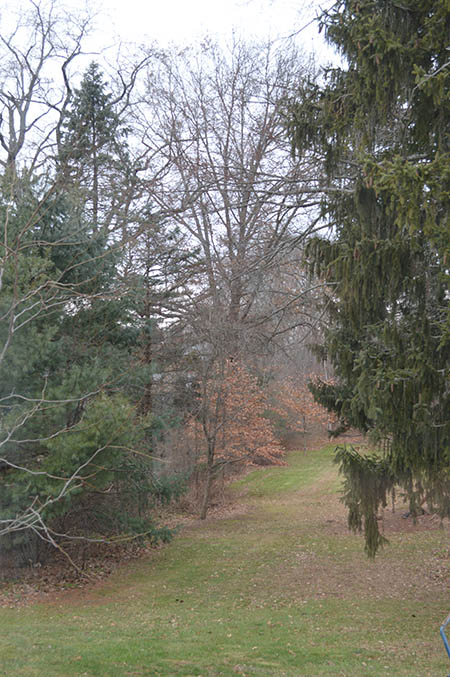
It has been, mainly, a good year for the world and county, and a good one for me. The era of COVID is not over, but the situation is much less dire than it was for a year or two. The violence following the 2020 election is over, but for the shouting. The easing of people's stress on both of these fronts has been apparent.
On the other hand, we have a new conflict in the Ukraine. That has led to disruption of on large scale in a world whose economy had become global. It's not clear at this point how much is saber-rattling and bluster, and how much is real. My experience is that people become upset and mistrustful a whole lot more quickly than they calm down and feel comfortable with each other. So, I suspect that on the economic level, things will go nowhere fast.
The relative calm – two steps forward and one step back add up to progress, if you think about it – has trickled down with its beneficial effects on my own life.
And so, the year is over, the harvest is in, and I am content.

Recent Massachusetts law requires communities to allow some multifamily housing at a certain minimum density. Like other laws that favor development, such as the State "anti-snob" zoning provisions, this one will create much controversy.
We live in partisan times, when people tend to fight to get their way rather than looking for common ground. Alas! Meanwhile, the figures of the established order, who are the authors and creators of the norms we have, not surprisingly feel that they are good ones.
Providing information and a calm presence, I have found, can lessen the excesses of partisanship. I am moving to do that, for this issue, with a community website.
Will there still be excesses? – No doubt. I will do my best to empathize and to be constructive. At least, that usually does not go unnoticed or unappreciated… or without effect.
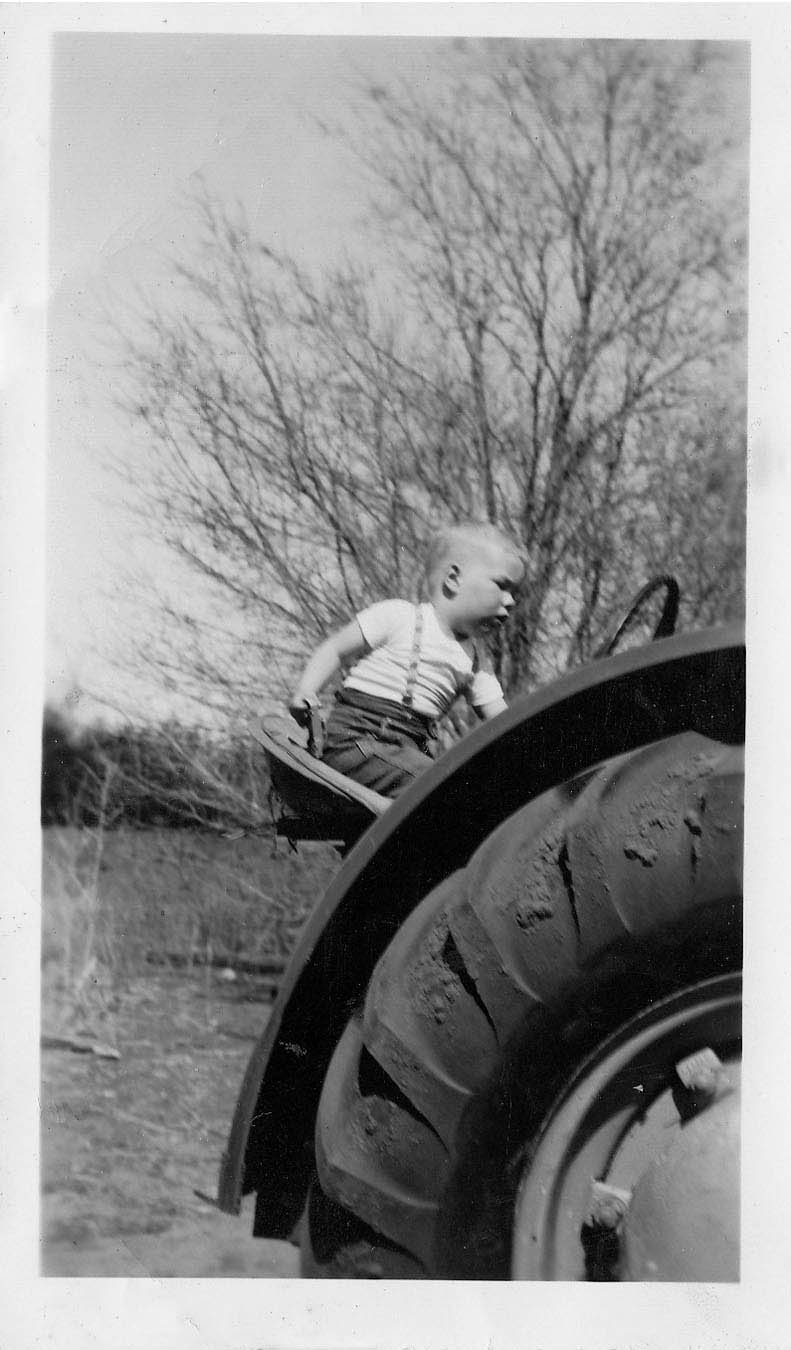
I am the boy pictured on the tractor, about seventy years ago on my grandfather's farm in Kansas. That farm was the love of my childhood and retains a tender place in my heart in my adulthood.
Twelve years ago, I bought a John Deere lawn tractor. It was a very exciting event. I think it was not so much a question of needing a tractor to cut the lawn, as of needing a lawn so I would have a place to drive a tractor around. Though the tractor was toy-sized compared to my grandfather's, I was – as the saying goes – as happy as a child.
The last couple of years, it has abruptly refused to proceed a number of times, each time at a moment when I particularly needed it. Few things throw my life off an even keel more than machines that don't work, in particular those with internal combustion engines. After some days of frustration and grouchiness, with some failed tries at basic fixes, I decided that the time had come for a new tractor. The current one had lasted more than twice as long as I expected to.

My new tractor is yet to arrive, but I am very happy already that I decided to proceed.
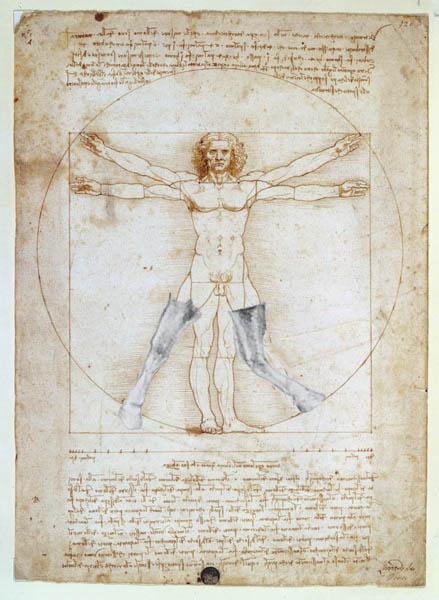
My career was in health care for the last decades of my working life, among some very fine, devoted, and smart people. In the middle of those years, discussion of medical errors rose to the fore. The phrase "medical errors" is such a dreadful-sounding one. Daily life includes countless minor missteps and slight misdirections, which get corrected and adjusted as we go along, without any particular notice or effort. Only a small number of these rise to the threshold of consequence, let alone harm.
My last annual PCP visit included three events that would typically be called "errors" in the medical safety community.
First, the physician assistant found a systolic blood pressure reading of 143, the highest ever in my life. My median value is 112. I questioned before the reading that it was to be taken over my shirt sleeve, but she said that shouldn't make a difference and proceeded. Researching the question afterward, I find it reported, "Wrapping the cuff over clothing is a common error that can add 5 to 50 points to a reading. Instead, be sure the cuff is placed on a bare arm." The physician was aware enough of the oddness of the result that he repeated the reading himself, finding a value of 129, high for me but within the extended range of normal for my age group. I suggested that result was influenced by my having been out in the cold and being uncomfortably underdressed in the exam room. He replied, "Maybe." Keeping daily records afterward, I have found an predictable correlation between my blood pressure and the outside temperature.
Second, before my visit, a nurse practitioner had placed orders for a broad panel of labs. These included a lipid panel. I have never had high lipid values in my life and had had a test about two years before. It is outside of any standard medical guideline to do repeat lipid tests so soon after a benign result. The physician agreed with my feelings and cancelled the order. When I went to the phlebotomist for a blood draw, I noted the cancellation to her and asked that no sample be drawn for lipids. She was incredulous. This, however, was within well-established and well-known patient rights. When the lab results came back, they included a lipid panel, I am not sure exactly why. Perhaps the phlebotomist felt I was out of my mind, perhaps she inadvertently proceeded by habit, perhaps the computer systems were off.
Third, I raised the question of a possible vitamin D insufficiency with the physician. He was open to the question and ordered tests including vitamin D and thyroid function. I realized at the the time that he was confusing thyroid and parathyroid glands, the latter being the one involved in calcium and vitamin D regulation. I didn't say anything, simply because I didn't want to embarrass him. At least he was open enough to say that he didn't know much about vitamin D, which I very much appreciated. This made it much easier to deal with the question.
None of these three errors had results beyond creating distractions from what would have been a better use of care time.
What I find most mistaken in my own experience of medical care is its egoism and egotism as a system. In that, it is like other large systems and species and invididuals, as described by Darwin and Schopenhauer. Each of us, to make it through a day, must think heed his own needs and follow his own views, which have become ingrained in each of us. Those may be symbiotic with, or opposed to those of other forces and entities, or simply heedless of them. – But that is matter for another day.

If you buy something from a local merchant and it is obviously defective upon unpackaging, it is expected that the merchant will offer a replacement or refund.
Things are more complex in our age of a global economy and high technology. Buyer and seller do not meet. The products are apt to come from far away, moving through mass distribution systems. Frequently they include electronic features involving chips and code with origins several layers removed, which the retailer and consumer cannot not begin to understand. Consumers' ways of getting information are indirect, with built-in biases. Amazon, for instance, allows reviews only within a few months of purchase time — which allows no consideration of durability. Third-party reviewers typically give more stars to products with more features – which, alas, means that there are more things that can go wrong and, I have found, frequently do.
I have come to appreciate the age of internet shopping, overall. It offers the potential of an enormous range of products, at prices below those before it. The expense and experience of an occasional dud purchase are far outweighed by the positives.
Usually I return things that are broken when I receive them. My understanding is that returned goods seldom go back to their originators. More often, batches of returned merchandise are bought up, for pennies on the dollar, by people who will salvage a little and discard the rest. Most web merchants allow returns for just about any reason. The loss they experience is just part of the cost of doing business and maintaining their reputation.
And so, I suppose, the relatively small cost of the occasional dud I purchase should fit into my overall budget as well. The problem is, this doesn't feel right. Reciprocity is a fundamental psychological need in any exchange. After all, web sellers do not ever fail to collect their money, even once in a rare while.
Well, I'm getting better at seeing the woods through the trees. But I have acquired the habit of not buying things from vendors who do not accept returns.
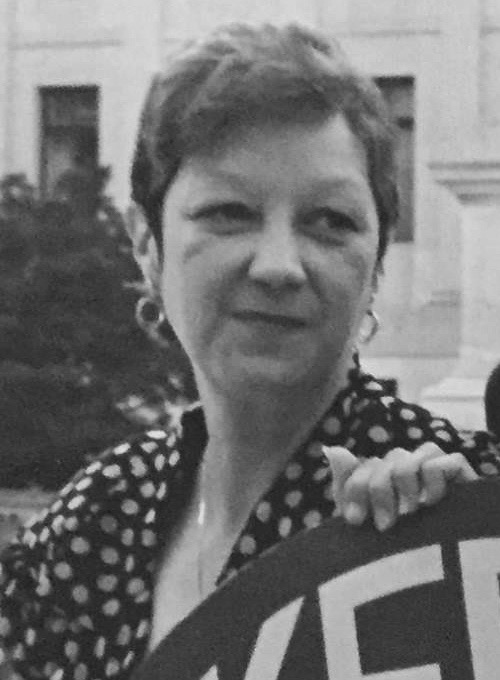
I am saddened by the recent Supreme Court decision. My reaction isn't based on constitutional law, or on a sense of strong moral principle. People reasonably disagree. In the absence of a compelling case that all need to act the same way, for instance to drive on the right side of the road, it seems most reasonable to allow each individual to act as he or she sees most appropropriate. I doubt that the question should ever be decided by Congress, state legislatures, or courts. Our culture emphasizes freedom of religion, and the question of when life begins is an abstract one that can't be empirically resolved. I am skeptical, to say the least, when someone presumes claim to special closeness to God, and on the basis of that self-proclaimed superiority of understanding, dictates what morals other people should practice.
Beyond that, it one more sad manifestation of the partisanship of our current culture. The first reaction is less often to look for possible agreement, more often simply to begin by fighting. The political winds have shifted, bringing in Supreme Court justices on a different side. Despite the lip-service to stare decisis, the practice has become, what's already been settled is settled – unless we think differently.

I am a peaceful soul, who have reacted with horror to Russia's invasion of the Ukraine. It felt like the ugliest of my childhood memories of school bullying.
I have been much surprised at Ukraine's success in resistance. Clearly, my preconceptions were off entirely. Realizing this leads me to want to understand better. My ignorance of things military exceeds my ignorance of quantum physics, which is nearly absolute.
Exploring, I find beginnings of an answer in the work of Carl von Clausewitz, the eminient military theorist. He marvels at the continual and mysterious triangle of emotion, chance, and intellect, noting that the position of defence is typically stronger. Here, the Ukrainians are protecting their own homeland, which they know far better than the invaders, many of the latter reluctant conscripts. Clausewitz remarks that three quarters of the information a commander would want is unavailable to him at the moment for action. The CIA is searching its soul over its failure to foresee the detemination of Volodymyr Zelensky – but that is part of what is commonly called the human factor, and so unknowable. How many of us really know exactly what our own limits will be in unforeseen circumstances?
I have had, I begin to realize, a naive faith that military leaders have an expertise and judgment that uninformed laypeople, including me, should not dream of questioning. No doubt, they have deep technical training and understanding. Technical knowledge, however, is hardly a sufficient base for good leadership and judgment abilities, especially in a species as frail and narrow-thinking as home sapiens. The difficulty is compounded when non-military persons, such as both Biden and Putin, are commanders-in-chief. History is full of lessons of ambitious and greedy political leaders who either refused to listen to their generals, or cowed the generals into sycophantic roles.
There is a very informative daily report on the war by the Institute for the Study of War. It seems unbiased and very well informed, several notches above the level of the mass media. I have found that it raises points that I wouldn't have thought of but make sense to me when I hear them: for instance, that the Russians have insisted on fighting battles for ground of almost no importance for the ultimate outcome, while the Ukrainians have been able to focus their resources for the long term objectives.
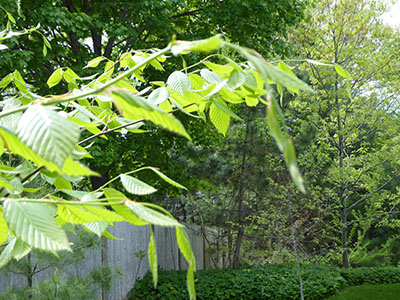
Most trees add the year's new growth in an incredibly short period of time, typically a couple of weeks in spring for deciduous species, somewhat more for evergreens. The beech shown here has shoots that grew eight inches in two days. The ends are still very saggy, as is normal. New growth for a young beech twig might reach, say, up to eighteen inches.
My question is, what do trees do the rest of the summer? There is almost no visible change, except perhaps the slow emergence of next year's buds, and a deepening of the green of the leaves. Are there invisible processes of growth and change going on inside, or is the status simply a holding pattern, the arboreal equivalent of breathing out and breathing in?
Of course, flowering, pollination and seed production are also essential processes. Usually the first two of these also occur very early in the season, and in an even shorter period of time than the growth of shoots and leaves. The growth of nuts and cones happens more slowly. I suspect that this is not so much because it is an intricate and laborious process, as because it is protective of these invaluable seeds to keep them for as long as possible out of the threatening external world, where they are apt to be eaten, beaten or mistreaten if they lie around idle for long.
If you have an answer, or part of an answer, please let me know. – Of course, we could ask similar questions about other forms of life, but my question is about trees, the giants who appear to sit idly by much of the time.
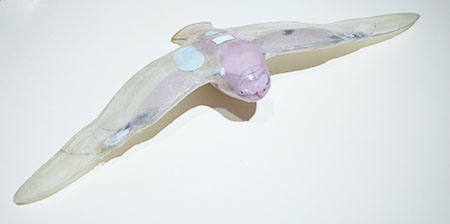
I have an ongoing interest in snowy owls as a subject for sculpture. The nearby Crane Estate is a winter habitat for them, so local people, even non-birders, recognize and relate to them. Young children, who are generally not interested in gallery-going, will stop and look at representations of snowy owls.
Birds in general are challenging to sculpt. Snowy owls in particular keep far distant from humans. They make movements faster than the eye can see. In flight they are high in the air, and not viewable from above. While they have bones and soft tissues that correspond to those of humans and other vertebrates, birds cover these with streamlined, aerodynamic surfaces. It's just very hard to fasten on their shapes.
My owls have, so far, been of stonework. I have fixed on the idea of making one in flight, but rocks don't lend themselves to that very well. I've been experimenting in epoxy resin and fiberglass, which seem to be just the thing for the purpose – except that my skills with it are only those of a beginner, which is what I am. Well, the craft is seeming very learnable, and mistakes can be fixed – that is why they use it for auto and boat body repair, after all. In the picture, you can see through the surface to the buried odds and ends of pink and light blue styrofoam, dark glue and other temporary supports. You should imagine it painted white, except for its beak and eyes.
The picture is of a half sized model. A full-sized one, which is what I have in mind, has a wingspan of five to six feet. Snowy owls are big birds.
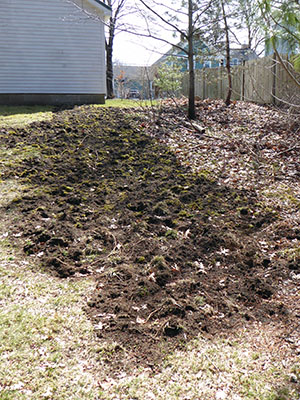
The end of March has been mild. The ground has thawed. There is no snow or ice around to be seen. There are no puddles or noticeable mud. There hasn't been a major winter storm wreaking broad devastation on trees. There are a few small branches down, but that's it.
Every year since I have owned my house, I have cleared an area of random wild growth, and sown it as lawn area. I am not fixated on grass as the only possible or even ideal solution, but I have found that invasive species quickly penetrate into other ground covers. The only way to control that voracious jungle is mowing, which quickly narrows the options and brings us back to grass. (I do mix in some clover. Clover coexists nicely with grass and fixes nitrogen from the air, obviating the need for applied fertilizer.)
The turned ground shown here is an area that was heavily shaded by a Norway maple, with a dense growth of moss underneath. The maple went down last year in a storm, affording new sun to growing things that were choked of light.
The totality of all of the tasks ahead of me for the coming warm months looks, thank heavens, manageable, in stark contrast to last year, when it was overwhelming. There are no doubt events ahead that I haven't planned on, but – barring very bad luck – there will be time to do what has to be done and then to smell the flowers and daydream.
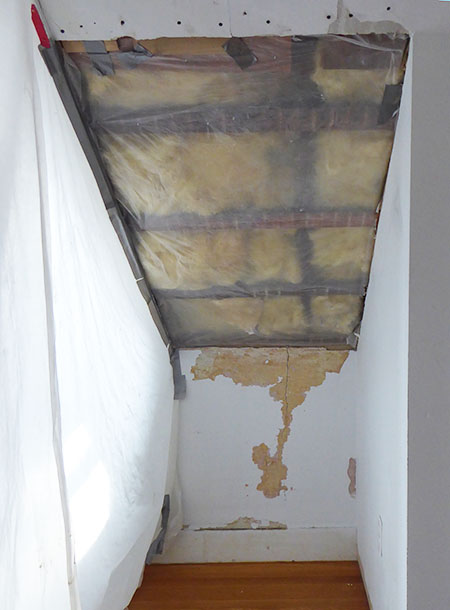
Most of us keep lists, usually mental and haphazard, of things that we should do, one of these days. Some things fall to the bottom, or fall out, because they aren't actually important, or because we just really don't want to do them.
My own list of dreaded tasks has included household maintenance jobs that are simply disruptive, preventing ordinary use of key areas of the house, or creating storms of filth and dust. Just about the oldest item has been repair of loose section of ceiling below a former roof leak. The initial phase of the work involved old plaster, coal dust, blown-in cellulose insulation, and rodent droppings falling from above in a fully furnished room of the house. Yuck. I built a tent and took down over the course of several days, pretty much handful by gloved handful, stuff that could have been pulled out in five minutes – but leaving in its wake a sanitary disaster, had I taken that approach. That part of the work is now complete, saints be praised, with its vapor barrier, which will block any futher fall of dust and other particles.
Well, it feels good to have the dirty part done, and the work going forward should be fairly clean and much more rewarding.
There were other such tasks I took on, refinishing a few worn areas of oak flooring, and installing lumber shelves in the basement. They weren't yippee-whee fun, but it is very satisfying to have them done. And the list has grown complete just as winter is fading. That conjunction of milestones does put a smile on my face, I must say.
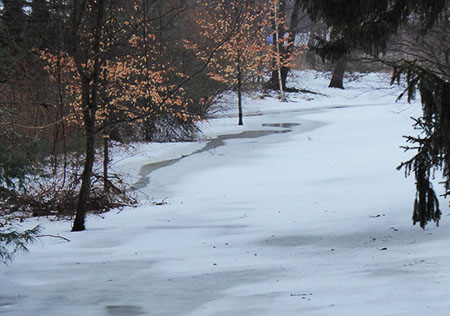
In some years, I have a vernal stream as the snow pack melts over the saturated ground above where I am. This year I have a very unusual and distinct winter stream. We had a significant snow not long ago, and in the last twenty-four hours a sharp thaw and ¾ of an inch of rain. The ground isn't saturated, but it is frozen.
This material first appeared on February 3 as a guest column in the Ipswich Local News.
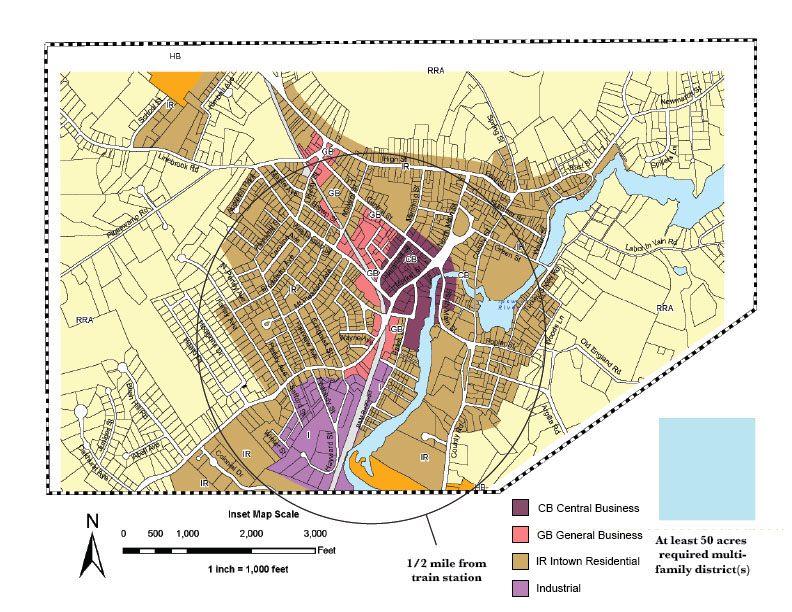
In January of 2021, a new Section 3A of Chapter 40A of Massachusetts General Laws went into effect, requiring designated MBTA communities to provide at least one district where multi-family housing is permitted as of right. The law provides that the district be “of reasonable size … not more than 0.5 miles” from an MBTA station, with “a minimum gross density of 15 units per acre.”
The Department of Housing and Community Development (DHCD) has drafted regulations to implement the law.
These require an appropriate zoning district of at least 50 acres. For Ipswich, the district will need to allow 971 multi-family units. The proposed regulations are open for comment through March 31.
The law does not mandate the creation of housing. In fact, central Ipswich is already heavily built out. Future growth will continue to be constrained by economic, historic, and conservation requirements, prior development, and the difficulty of adding off-street parking.
A preliminary count of existing dwellings within 0.5 miles of the Ipswich train station estimates about 1,300 units, about 750 multi-family units, and 550 one- and two-family units. The draft rules do not take existing housing into account.
Although the proposed regulations do not require that all the area within 0.5 miles allows a density of 15 units / acre, at least 50 acres (about 1/10th of it) must. For Ipswich to reach the required total of 971 units, it would have to increase the density to 20 units / acre or the total area to 60 acres.
Ipswich already allows multi-family housing in much of its central areas but generally requires a special permit. The central business and general business districts together comprise about 50 acres.
Ipswich zoning and its Community Development Plan currently focus on this area for future development.
The new zoning requirements must allow multi-family housing, but that may be subject to other density restrictions.
Specifically, zoning may set a maximum floor area ratio (FAR) — the building floor area / lot area. For example, an acre with 15 two-bedroom units of 1,200 square feet each has a FAR of 0.41, well within the range of existing neighborhoods.
What options does Ipswich have? It is realistic to expect that the governor and legislature will leave the recently enacted law as-is with requirements for new zoning regulations to allow multi-family housing.
It seems fair and reasonable to ask DHCD to consider adjustments in specifics of its proposed guidelines to take existing dwellings into account.
Meanwhile, the town must consider options for implementing the regulations as proposed. These might remove special permit requirements in downtown areas at the same time as refining restrictions on density, such as FAR limits.
There is substantial agreement between the state and the town on goals in concept. Where ideas on implementation vary, the town will need to work at advancing specific plans — perhaps with DHCD agreement to refine its proposed regulations to credit work already done, perhaps without.
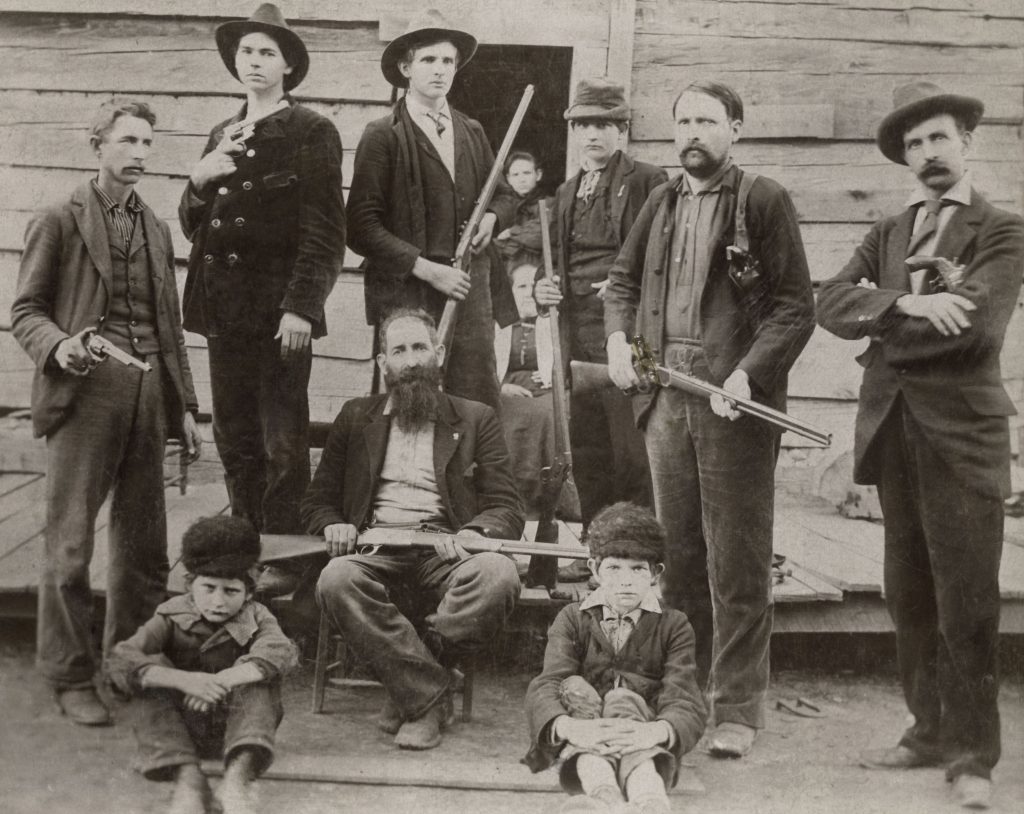
The Hatfields
I am fascinated by the movement of our society towards polarized political views, especially when the viewpoints from one pole are may not be internally self-consistent, but are consistent in being against the views from the other pole. If there is evil – which there must be if there is good – our human minds prefer to take the evil as external. In the absence of an ongoing foreign conflict to supply pre-packaged, off-the-shelf villains, we may seize on the expedient of making bad guys out of each other.
I recently found a very enlightening study in Nature.
Examining political content, we find that Reddit underwent a significant polarization event around the 2016 US presidential election. Contrary to conventional wisdom, however, individual-level polarization is rare; the system-level shift in 2016 was disproportionately driven by the arrival of new users. Political polarization on Reddit is unrelated to previous activity on the platform and is instead temporally aligned with external events. We also observe a stark ideological asymmetry, with the sharp increase in polarization in 2016 being entirely attributable to changes in right-wing activity.Isaac Waller & Ashton Anderson, Quantifying social organization and political polarization platforms.
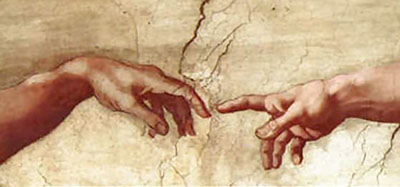
As Winston Churchill observed, the veils of the future are lifted one by one, and mortals must act from day to day. For starters, it is reasonable to anticipate that the future will be like the present, only longer.
For humankind, there are some currents whose direction seems sobering. The compelling collective focus of the moment is the viral pandemic. At the beginning of 2022, the description "COVID Nineteen" is ironic and oxymoronic. One remark in recent news seems to put it rather well: we need to "learn to live with COVID." The national and world economies are lurching along, encouraged by massive injections of currency. The disruptions in discretionary spending and global supply chains have non-economic causes in tangible health threats, however, which will not go away with increases in the money supply. Meanwhile, the distribution of added assets and spending power is not even across all classes and sectors of society, or from one moment to another, inevitably leading to disparities and increased pain for some, certainly without the predictability and security that the humble and the mighty both crave.
This is to say nothing of climate change, which many very responsible and well-informed people say is a greater, though less immediate, threat than the virus.
– Is there a bright side to all of the circumstances of our society and planet? – I see bright moments and events. What lies ahead? – I don't know the future, any more than anyone else does.
My own life is much more under my own control than the affairs of the planet, and is going well. Last year was an overwhelming one for me much of the time, between my own (over-) ambition, some unfortunate combinations of external circumstances, and an apparent decline in my overall functional status. The health issue is now resolved, and external circumstances will be no more or less under my control than they have been. This leaves me with my own ambitions to shape. I am feeling comfortable and happy with the prospects.
– And, for the present, I will revert to wearing a mask in public indoor spaces. It's not a big deal, and it's the responsible thing to do.
© 2026 Paul Nordberg